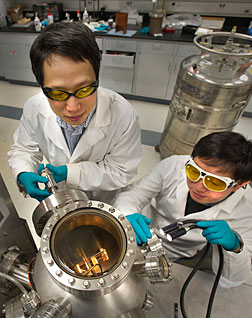- Number 380 |
- January 21, 2013
Breakthrough iron-based superconductors set new performance records

Brookhaven physicists Weidong Si (left)
and Qiang Li.
The road to a sustainably powered future may be paved with super-cold superconductors—remarkable materials that are singularly capable of conducting electric current with zero loss. But strict limits on operating temperature, high costs, and the dampening effects of magnetic fields currently impede widespread adoption. Now, a collaboration led by scientists at DOE’s Brookhaven National Laboratory have created a high performance iron-based superconducting wire that opens new pathways for some of the most essential and energy-intensive technologies in the world.
These custom-grown materials carry tremendous current under exceptionally high magnetic fields—an order of magnitude higher than those found in wind turbines, magnetic resonance imaging (MRI) machines, and even particle accelerators. The results—published online January 8 in the journal Nature Communications—demonstrate a unique layered structure that outperforms competing low-temperature superconducting wires while avoiding the high manufacturing costs associated with high-temperature superconductor (HTS) alternatives.
“A key breakthrough here is the discovery that adding layers of cerium-oxide in between the films and substrates dramatically increased the superconductor’s critical current density, or maximum electricity load, as well as the critical temperature at which the material becomes superconducting,” said Brookhaven Lab physicist Qiang Li, head of the Advanced Energy Materials Group and leader of this study. “That critical temperature threshold rose 30 percent over the same compound made without this layering process.”
The team used a fabrication technique called pulsed-laser deposition, which uses a high-power laser to vaporize materials that are then collected in layers on a substrate, to create chalcogenide-based superconducting films of iron, selenium, and tellurium. This complex technique is a bit like carefully collecting the gas as it rises above a boiling pot, only with nearly atomic-level precision.
When tested, the critical current density of the new iron-based superconductor reached more than 1 million amperes (amps) per square centimeter, which is several hundred times more than regular copper wires can carry over the same area. Under an intense 30-tesla magnetic field, the film carried a record-high 200,000 amperes per square centimeter. For scale, consider that household circuit breakers usually blow when hitting just 20 amps.
The researchers extended the study to include thin films grown on flexible metallic materials called rolling-assisted biaxial textured substrates, or RABiTS. These substrates, developed in a proprietary process invented at Oak Ridge National Laboratory, offered a similar performance with particularly important implications for long-length, scaled-up production.
“The next step is to pinpoint the mechanism behind the findings—the relationship between the structure and properties—which will provide guidance for the discovery of new superconductors with even greater performance,” Qiang Li said.[Justin Eure, 631.344.2347,
jeure@bnl.gov]
